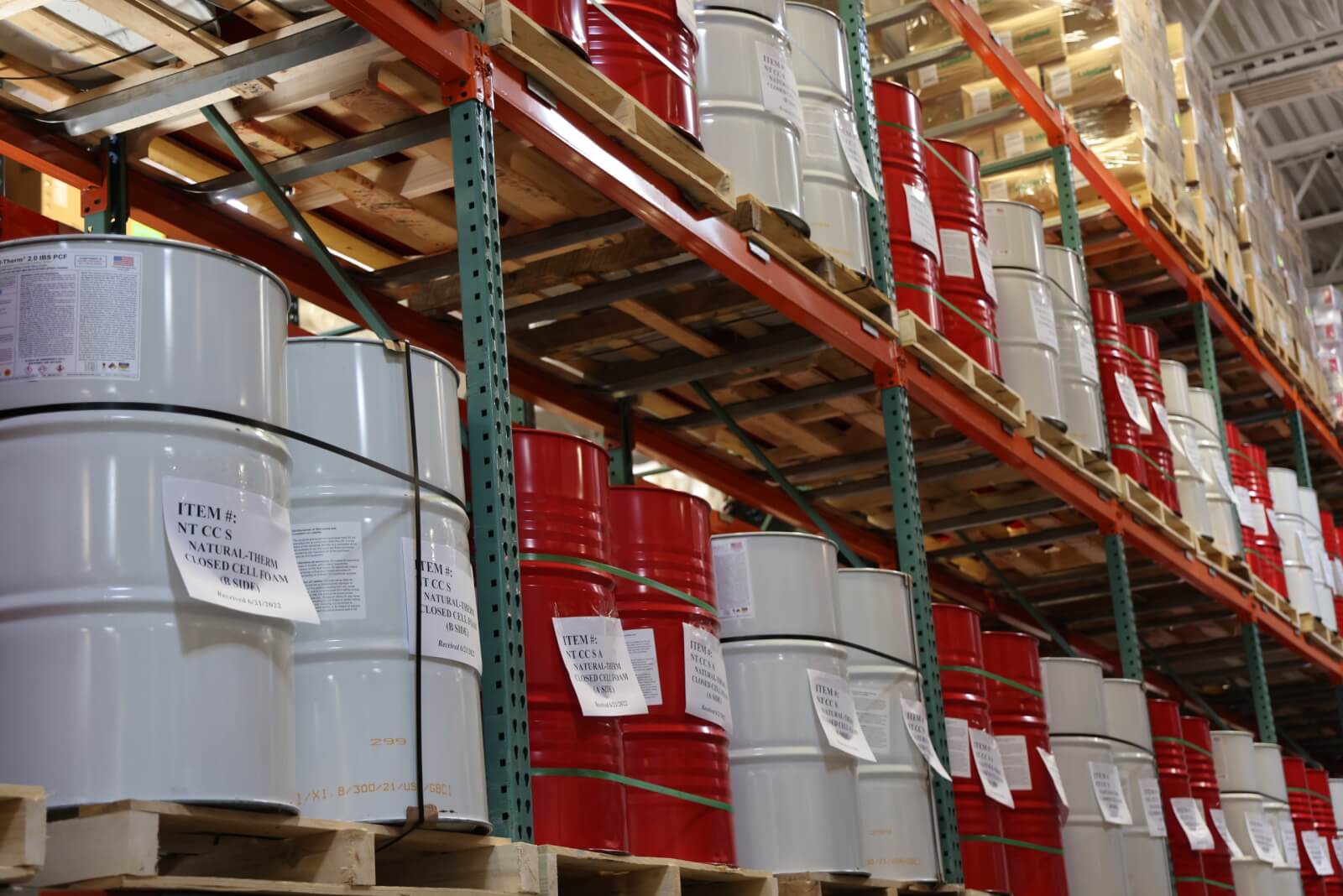
Spray foam insulation can be intimidating. You not only need to understand the equipment and materials, but also whether you’re making a profit or losing money — making accurate job costing crucial. Overeager and over-ambitious contractors often rush to the bottom, aiming to be the cheapest bid just to win work. This strategy puts lots of companies out of business. Underbidding without checking the accuracy of the other company’s bid or your own profitability is a dangerous game of slim margins. Creating your own bid is the safer route, especially since it will give you a better idea if there is any wiggle room in your profits to competitively bid without losing money in the process. Not sure how to put a bid together? IDI is here to help! Check out our guide below or reach out to our experts with questions. Want to learn more about starting your spray foam business? We have you covered there too.
1. Know Your Foam
Knowing the foam you’re spraying and how to get the most out of it is one of the keys to making profitable bids. Spray foam blends are proprietary, each with different properties, densities and processing requirements — even the rig and crew applying the foam can make a difference in application. Finding one kind of foam you like and sticking with it will help you and your crew develop an expertise and can help make the bidding process easier.
If you can learn how to accurately calculate the amount of foam coverage you need for each job and spray with the right technique, you’ll be in a great spot for bidding. On the other hand, not having a good understanding of your chemical can lead to spraying more board feet than you used to calculate your bid, cutting into your profits.
Want to fine-tune your technique or get expert instruction on spray foam materials? Check out IDI’s upcoming trainings!
2. Measure the Whole Area
When measuring a job, it’s good to either start at the top or the bottom so you don’t miss anything. It doesn’t matter which starting point you choose, but getting in the habit of doing it the same way will help keep your process consistent.
Most projects require insulation in the walls and the attic assembly. Depending on where you’re located, the attic package may change from insulating the ceiling to insulating the roof deck. In the south, ductwork and mechanical is traditionally put in the attic, so spray foam provides a major advantage by shifting the insulation from the attic floor to the roof deck, moving the ductwork and mechanical into conditioned space. In the north, most of the mechanical work is in the basement, so spraying the roof is normally unnecessary and adds cost. Make sure you know the customer’s expectation and where insulation is needed before putting a bid together.
The most important part of measuring? Taking your time and being precise. Just like anything, bidding work — and getting that work — is all in the details.
Measuring Walls
Many contractors measure using traditional tools like tape measures, wheels and lasers, but if you can count, you can measure, especially in square and rectangle rooms. Typical wall cavities are 16” or 24” on center. Counting studs 24” on center is easy for footage, but even 16” cavities have an easy trick: every three studs make four feet or 1.33 feet for each stud counted. For example, if you count 85 studs when you walk the walls, multiply 85 by 1.33 for a total length of 113.05’. If the wall is 8’ tall, multiply that 113.05’ by 8’ to get your total square footage of 904.4.
Measuring Ceilings
To measure square footage of the ceiling or attic, you need to know where the insulation is to be installed beforehand. Flat ceilings are the easiest, with trusses traditionally 2’ on center, so length can be calculated by counting the trusses and multiplying by two. That length multiplied by the width from your wall measurements will give you the square footage.
If you are insulating the roof deck, there’s a cheat here as well. Traditional plywood comes in 4’ x 8’ sheets. If we count the seams from the eve wall to the ridge cap, we multiply that number by four. Keep in mind, the ridge cap also counts as a seem and if it’s not counted, you will be short by one sheet of plywood. For example, if there are seven seams from the eve to the ridge, multiple seven by four to get 28 feet. Then, multiply that by two to account for the other half of the house for the width — 56’ — and then multiply by your length for your square footage.

3. Calculate Board Footage
Calculating board footage is done by taking the square footage of every area you will be insulating and multiplying it by the number of inches, or thickness, of foam being installed in each area.
For example, if you have a 1,375 square foot area and the plan calls for three inches of foam, the equation would be 1,375sq ft x 3” of foam = 4,125bf (board feet).
4. Establish Material Cost
Once you have figured out how much spray foam coverage a job will need, you can calculate the material cost. If you are spraying a job with a total of 6,073bf calling for closed cell foam (4,500bf average per set), divide the total bf needed by the average set coverage: 6,073bf/4,500bf = 1.35 sets. For this example, pretend a set of foam costs $2,500.
- To get cost per bf, divide set cost by average coverage: $2,500 / 4,500bf = $0.55 per board foot.
- Material cost is the total project bf area multiplied by the cost per board foot: 6,073bf x $0.55 = $3,340.
While we would all like to be perfect applicators in the field, it is smart to bump up costs slightly for overspray or waste. Not every job can be done perfectly down to the exact board foot, so having a little wiggle room is helpful.
5. Add Additional Costs
Once the cost of material is known, you can decide what other costs you need to add to the bid, including:
- Labor
- Equipment replacement
- Marketing
- Insurance
By tracking how much material you use — the lifespan of your equipment and the rough time it takes to do jobs of various sizes — you’ll start to have a good idea of what these extra costs will be.

6. Put Together Your Bid
Long gone are the days of scribbling on a napkin and delivering the quote to your customer “within a week.” Today, bids need to be accurate, fast and a bit more official. It takes work to learn how to bid quickly and correctly, so IDI has developed BIDIT: a bidding software that can be loaded with your material and accessory pricing, as well as the margin you hope to achieve.
BIDIT works from any device, requiring just the project’s square footage, the accessories you need and the margin you want. The quote is built and ready to be emailed to your customer within minutes. While it is good to know how to create a bid from scratch so you understand the process, harnessing the benefits of purpose-built software will let you bid faster and keep up with customer expectations.
7. Lowering Your Bids Without Losing Profits
There’s no doubt that lower bids are usually the most competitive, and there are ways to lower your bid pricing without losing out on profit. Some good tips for tighter bids include making sure you don’t overfill the rim joist and staying close to the board feet promised in the contract. But the number one way to lower your price? Use less product more efficiently.
Ideally, we want to be swift, but accurate while installing foam. When combined with proper technique, you can improve your yield while cutting down on waste. As you continue to improve processing your chemical, you may find you can get extra board feet from each set of foam. Those extra board feet can add up to a lot, especially as your business grows. For example, getting 200 extra board feet a day can add up to $50,000.00/year. Wasteful, too-fast applications can lose those savings instead, keeping bids high.
Better Bidding for Better Business
The bidding process can be frustrating, but by taking the time to learn how to do it properly and competitively, you give your business the best opportunity to succeed. And by partnering with the experts at IDI, you can make the process easier than ever before. For more information on spray foam coverage, yields, board foot costs, job costing and how to bid for spray foam or on any of the products we carry, reach out to your local branch, or any of us at IDI, where we look forward to earning your business every day.